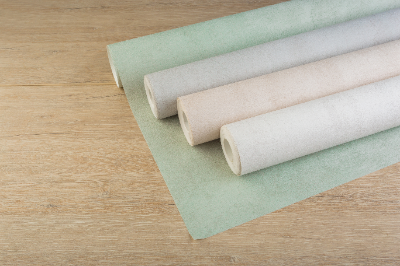What Is Paper Cloth?
 Paper cloth is wallpaper whose raw material is paper.
Paper cloth is wallpaper whose raw material is paper.
In Europe and the United States, there are many paper cloth wallpapers made from pulp, while in Japan, vinyl cloth wallpapers are more common. Paper cloth is classified into Western-style cloth, Japanese-style cloth, and non-wood, paper cloth. In addition to these, there is also synthetic paper with a film-processed surface.
Paper cloth is thinner than vinyl cloth, so priming is important. If the preparation is poor, the joints of the substrate will show, making it particularly difficult to put up on walls with uneven surfaces. In addition, it may expand and contract, and the joints may stand out, so the skill of the installer is important.
Uses of Paper Cloth
Paper cloth can be used as a paper material to enhance the packaging of Japanese and Western confectionery shops and sake breweries because it can produce a unique depth of color and a texture like real cloth or leather, which is difficult to express through printing. Foil stamping can be used to create a sense of luxury.
Paper cloth has been attracting attention in recent years because of its environmental friendliness. Its raw materials are natural and gentle to the indoor environment, and it can be used for finishing office and office walls. Increasingly, it is also being used for bedroom walls.
Paper cloth in Europe and the United States is often bold in design, making it suitable for creating unique rooms.
Principles of Paper Cloth
Paper cloth can be divided into three types: impregnated paper, non-impregnated paper, and vinyl paper cloth.
1. Impregnated Paper
To increase the strength of paper cloth, a special resin is soaked into the base paper before coating and embossed with a leather-like pattern. This makes it strong and rich in perfection.
2. Non-Impregnated Paper
Non-impregnated paper is based on ultra-thin paper or kraft paper, coated with pigment dyes, and finished by embossing. This cloth has a unique feel with a glossy sheen. It is used not only for packages and covers of top-bound books but also for packages and covers of textbooks and bankbooks.
3. Vinyl Paper Cloth
Vinyl paper cloth is based on kraft paper and coated with various synthetic resins such as acrylic, vinyl chloride, urethane, and nylon, plus colorants and plasticizers. They are glossy, tear- and rub-resistant, and flexible.
Types of Paper Cloth
Paper cloth is classified into Western-style cloth and Japanese-style cloth.
1. Western-Style Paper Cloth
Many types of wallpaper are available in many colors and designs, including those embossed with botanical prints and gorgeous patterns. Many imported materials are also used.
2. Japanese-Style Paper Cloth
Typical Japanese paper is made from kozo (paper mulberry) or mitsumata. Paper cloth made from kenaf and flax are also available.
This cloth has the unique texture of washi. They also absorb moisture and release it when dry, and have a sound-dampening effect. Paper cloth began to be widely used after World War II, around 1955, replacing painted walls that had been the mainstream.
How to Select Paper Cloth
While Japanese paper wallpaper offers a unique texture, Western paper cloth offers bold plant prints, gorgeous embossed patterns, and other colors and designs not found in Japan.
Non-wood, paper cloth is said to help protect the environment. This is because the plants used to make non-wood, paper, such as kenaf and flax, grow quickly and absorb carbon dioxide.
However, paper cloth is more expensive than vinyl and requires more labor to replace. Because of its vulnerability to water, it is often coated with plastic or other resins.
Although water-repellent, its lack of thickness makes it difficult to clean with water or chemicals, and oil and water stains easily stain it. The expansion and contraction of the paper may cause the joints in the wallpaper to stand out, and because it is susceptible to abrasion, it must be handled delicately.
Structure of Paper Cloth
Paper cloth is mainly made from non-wood paper such as Japanese paper and kenaf. Paper is a material that can absorb sound through air and is environmentally and health conscious. Most wallpaper is imported, but there is also handmade Washi paper cloth, which is attracting attention.
However, some paper cloth cannot be wiped with water, so care must be taken when caring for it.